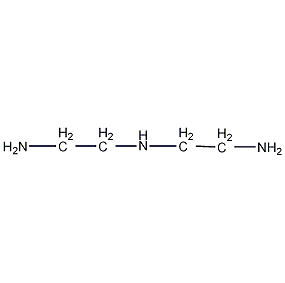
Structural formula
| Business number | 033E |
|---|---|
| Molecular formula | C4H13N3 |
| Molecular weight | 103.17 |
| label |
N-(2-Aminoethyl)-1,2-ethylenediamine, diethylenetriamine, Bis(β-aminoethyl)amine, Secondary ethyltriamine, diethylenetriamine, N-(2-Aminoethyl)-1,2-ethylenediamine, Double(β-aminoethyl) amine, second ethyl amine, Epoxy resin hardener, gas purifier, gasoline additives, Surfactant, fabric finishing agent |
Numbering system
CAS number:111-40-0
MDL number:MFCD00008171
EINECS number:203-865-4
RTECS number:IE1225000
BRN number:605314
PubChem number:24894288
Physical property data
1. Properties: colorless or light yellow liquid with ammonia smell.
2. Density (g/mL, 20/20℃): 0.9586
3. Melting point (ºC): -39
4. Boiling point (ºC , normal pressure): 208, industrial boiling range 185 ~ 210
5. Refractive index (20ºC): 1.48443
6. Viscosity (mPa·s, 20ºC): 7.1
7. Flash point (ºC): 101.7
8. Fire point (ºC): 398.9
9. Heat of vaporization (KJ/mol, 208ºC): 9751
10. Heat of evaporation (KJ/mol, 133ºC): 5802
11. Vapor pressure (kPa, 20ºC): 21.3
12. Volume expansion coefficient (K-1, 20ºC): 0.00088
13. Solubility: Miscible with water, ethanol, and acetone. It has stronger solubility than ethylenediamine and is an excellent solvent for many organic compounds, but it is insoluble in ether.
Toxicological data
Toxicity classification Highly toxic
Acute toxicity Rat oral LD50: 2.08g/kg; Guinea pig transdermal LD50: 0.17mL/kg.
Irritation data Skin – Rabbit 10 mg/24 hours Severe; Eyes – Rabbit 750 mcg Severe.
It is irritating to the skin, mucous membranes, eyes and respiratory tract, and can cause skin allergies and bronchial asthma. Inhalation or contact can cause conjunctivitis, keratitis, dermatitis, tracheitis, asthma, nausea, vomiting, etc. The maximum oral lethal dose LD50 is 1.8mg/kg body weight. The maximum allowable concentration at the production site is 1 mg/L.
Ecological data
The distillate, which contains a small amount of ethylenediamine, can be concentrated and recovered; the distillate with a temperature between 110 and 118°C at the top of the tower is 30% to 70% of crude ethylenediamine, which is 70% after distillation and concentration. of ethylenediamine products. After the residue from the concentration kettle is discharged, the sodium chloride is filtered off, and the filtrate is divided into two layers. The oil in the upper layer is a mixture of vinylamine products, and the lower layer is concentrated alkali liquid, which can be recycled for neutralization reaction.
4.Fractional distillation moves the ethyleneamine mixture from which the alkali has been separated into rectification In the tower kettle, fractionation is carried out under normal pressure. When the temperature at the top of the tower is 115-118°C, the obtained ethylenediamine is collected. Then perform fractional distillation under reduced pressure. Under a vacuum of 98.64KPa, the fractions at 90-140°C are collected into diethylenetriamine, the fractions at 140-180°C are into triethylenetetraamine, the fractions at 180-200°C are into tetraethylenepentamine, and the fractions at 200°C are divided into All the above distillates are polyethylene polyamines; when the ratio of dichloroethane to ammonia is 1:6 (molar ratio), diethylene triamine accounting for 26% of the output can be obtained according to the above method.
Purpose
1. Mainly used as solvents and organic synthesis intermediates for the preparation of gas purifiers (for CO2 removal), lubricating oil additives, emulsifiers, photographic chemicals, surfactants, fabric finishing agents, paper enhancers, ammonia Carboxy complexing agent, ashless additive, metal chelating agent, heavy metal hydrometallurgy and cyanide-free electroplating diffusion agent, brightener, ion exchange resin and polyamide resin, etc. Used as a room temperature curing agent for epoxy resin, the reference dosage is 8-11 parts by mass, and the curing conditions are room temperature/24h or 100℃/30min. 2. This product is used as a normal temperature curing agent for epoxy resin. The dosage for liquid epoxy resin is 11 parts. The pot life of 50g resin complex is 25min (23℃). Mainly used in laminate products, cast products, adhesives and coatings, etc. The general dosage is 5 to 10 parts. This product is also used as a solvent for the preparation of gas purifiers, lubricant additives, emulsifiers, photographic chemicals, surfactants, fabric finishing agents, paper enhancers, ashless additives, metal chelating agents, and heavy metal wet processes. Metallurgical and cyanide-free electroplating diffusion agent, brightener, ion exchange resin and polyamide resin, etc. 3. Used as a room temperature curing agent for epoxy resin, the reference dosage is 8 to 11 parts by mass, and the curing conditions are room temperature/24h or 100℃/30min. The thermal deformation temperature of the cured product is 90~125℃. It is also used in the manufacture of polyamide resins, ion exchange resins, surfactants, lubricant additives, fabric finishing agents and photographic chemicals. It is also commonly used as organic synthesis intermediates, solvents, gas purifiers, paper enhancers, aminocarboxylic complexing agents, metal chelating agents, brighteners, etc.

 微信扫一扫打赏
微信扫一扫打赏

